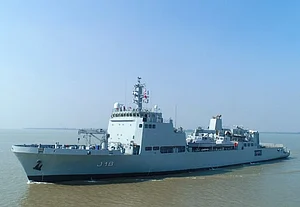
Name: The Indian Navy
The Indian Navy which is the maritime branch of the Indian Armed Forces, operates under the supreme command of the President of India. A four-star admiral, the Chief of Naval Staff, commands the Navy. As a blue-water navy, the Indian Navy operates extensively in regions including the Persian Gulf, the Horn of Africa, and the Strait of Malacca and routinely conducts anti-piracy operations. It also partners with other regional navies and conducts long deployments in the South and East China Seas and the Western Mediterranean Sea.
The primary objective of the Indian Navy is to safeguard India's maritime borders. In conjunction with other Armed Forces, it acts to deter or defeat any threats or aggression against India's territory, people, or maritime interests, both in war and peace. The Navy promotes bilateral relations between nations through joint exercises, goodwill visits, and humanitarian missions, including disaster relief.
As of June 2019, the Indian Navy had 67,252 active personnel and 75,000 reserve personnel, with a fleet comprising 150 ships, submarines, and 300 aircraft. As of September 2022, the operational fleet included two active aircraft carriers, one amphibious transport dock, four landing ship tanks, eight landing craft utility, 12 destroyers, 12 frigates, two ballistic missile submarines, 16 conventionally powered attack submarines, 18 corvettes, one mine countermeasure vessel, four fleet tankers, and various auxiliary vessels.
The origins of the modern Indian Navy trace back to 1612, when the East India Company's naval arm, which later became the Bombay Marine, was formed. In 1834, it was renamed Her Majesty's Indian Navy, and in 1934, it became the Royal Indian Navy (RIN). The RIN played a significant role during World War II.
After India's independence in 1947, the RIN was divided between India and Pakistan. In 1950, the Royal prefix was dropped, becoming the Indian Navy. During the 1961 liberation of Goa, the Navy supported troop landings and provided fire support. In the 1971 Indo-Pakistan War, the Navy enforced a naval blockade of East and West Pakistan and carried out successful operations like Operation Trident and Operation Python.
The Indian Navy has participated in various international missions and exercises. It was crucial in the 2004 Indian Ocean earthquake and tsunami relief operations. The Navy launched Operation Sukoon during the 2006 Israel-Lebanon conflict, rescuing civilians from war-torn areas. In 2008, Indian Naval vessels launched international relief operations for Cyclone Nargis in Myanmar. The Navy has also conducted anti-piracy patrols in the Gulf of Aden since 2008.
In February 2011, the Indian Navy launched Operation Safe Homecoming to rescue Indian nationals from Libya. During the 2015 crisis in Yemen, the Navy conducted Operation Raahat, rescuing thousands of individuals. The Indian Navy also participates in bilateral and multilateral naval exercises with other countries to enhance naval cooperation and security.
The Indian Navy's current structure includes three operational commands: the Western Naval Command, the Eastern Naval Command, and the Southern Naval Command. Each command is headed by a Flag Officer Commanding-in-Chief (FOC-in-C) of the rank of Vice Admiral. The Navy also has the Andaman and Nicobar Command, a unified command involving the Indian Army, Indian Air Force, and Indian Coast Guard.
The Indian Navy operates various bases across India for logistics, maintenance, ammunition support, air stations, hospitals, coastal defence, and submarine and missile boat bases. Notable bases include INS Shivaji, INS Kadamba, and INS Kattabomman. The Navy is also developing new bases like INS Varsha for nuclear submarines.
The Indian Naval Air Arm operates several air squadrons, including fixed-wing aircraft, helicopters, and unmanned aerial vehicles (UAVs). The Navy's air assets include MiG-29K, Kamov-31, HAL Dhruv, and Boeing P-8I aircraft. The Navy also maintains an aerobatic display team, the Sagar Pawan.
The Marine Commando Force (MARCOS) is a special operations unit of the Indian Navy, established in 1987 for amphibious warfare, counter-terrorism, direct action, and special reconnaissance. MARCOS has been involved in various operations, including Operation Pawan, Operation Cactus, and anti-piracy missions.
The Indian Navy's fleet includes a mix of domestically built and foreign vessels, such as aircraft carriers, amphibious transport docks, destroyers, frigates, corvettes, and submarines. The Navy's weapon systems include BrahMos missiles, Harpoon Block II missiles, and Barak surface-to-air missiles. The Navy also relies on electronic warfare systems and information technology for enhanced operational capabilities.
The Indian Navy conducts regular fleet reviews, with the President of India inspecting the fleet as the supreme commander. The Navy also organises international fleet reviews to strengthen diplomatic relations and military compatibility with other nations.
The Indian Navy is engaged in various future developments, including expanding naval bases, constructing new aircraft carriers, and acquiring new surface combatants and submarines. The Navy plans to have over 150 ships and nearly 500 aircraft by the end of the 14th Plan. The Indian Navy continues to evolve as a significant maritime force in the region.






















